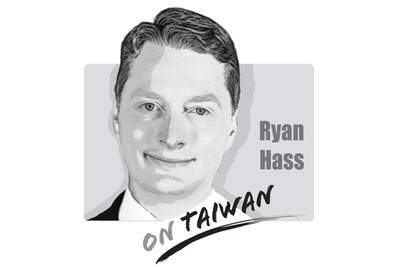It does not start for six months, but the buildup to the UN’s annual climate conference is already well under way in Brazil. Hosting the tens of thousands of delegates who make the trip is a big undertaking for any city, but the decision to host COP30 in Belem, at the mouth of the Amazon river, has multiplied the complications.
After three consecutive COPs in autocratic nations, the stated aim COP30 chairman Andre Aranha Correa do Lago is to make this year’s event a showcase for civil society, including the Indigenous groups and forest defenders who play such a vital role in conservation.
However, the lack of affordable accommodation and other infrastructure, as well as the distance that must be traveled to reach the Amazon port, mean this commendable ideal will be hard to realize.
Dom Phillips’ posthumously published book, How To Save the Amazon: A Journalist’s Deadly Quest for Answers, is a compelling reminder of what is at stake. It is nearly three years since he was killed along with Bruno Pereira, a Brazilian government employee whose job was monitoring isolated Indigenous groups. The pair were on the way back from a trip to the remote Javari valley. The search and investigation were initially botched. Two men will go on trial for murder later this year.
Phillips and Pereira understood the risks they ran, in struggling to document the destruction that was then taking place. Between 2019 and 2023, under former Brazilian president Jair Bolsonaro, progress on rainforest conservation went into sharp reverse and deforested areas grew rapidly. Illegal loggers, miners and ranchers effectively had carte blanche, as the agencies tasked with upholding environmental regulations were weakened and disbanded. Over the same period, and encouraged by the government’s laissez-faire approach, competition between drug traffickers over lucrative smuggling routes intensified. Owing to its remoteness, the Javari reserve, near the border with Peru, became a key battleground.
Under Brazilian President Luiz Inacio Lula da Silva the situation has stabilized. Lula’s environment minister, Marina Silva, is the right person to oversee the government’s policy of zero net deforestation by 2030.
However, plans to expand the country’s fossil fuel production are impossible to square with these environmental goals. The risk that global heating and deforestation could cause a mass dieback of the rainforest, triggering the release of vast stores of carbon, continues to trouble scientists. At the same time, doubts are growing about whether this year’s deadline for certification of the beef supply chain as deforestation-free will be met.
Under strong international pressure, JBS, the world’s largest meat company, is putting new systems in place, but the huge number of farmers (Brazil has a cattle herd of 240 million), the terrain, gaps in land registration and systems set up to bypass checks, mean the prospects for success are not high.
Having the global spotlight on the forest should at least focus minds. The Amazon’s biodiversity and role in climate regulation make it too important to lose. Indigenous defenders, some of whom worked with Pereira and Phillips, continue the vital work of championing the landscape that is their home.
The journalist’s book, completed by his friends, shows the urgency of supporting their courageous efforts.

China has not been a top-tier issue for much of the second Trump administration. Instead, Trump has focused considerable energy on Ukraine, Israel, Iran, and defending America’s borders. At home, Trump has been busy passing an overhaul to America’s tax system, deporting unlawful immigrants, and targeting his political enemies. More recently, he has been consumed by the fallout of a political scandal involving his past relationship with a disgraced sex offender. When the administration has focused on China, there has not been a consistent throughline in its approach or its public statements. This lack of overarching narrative likely reflects a combination
US President Donald Trump’s alleged request that Taiwanese President William Lai (賴清德) not stop in New York while traveling to three of Taiwan’s diplomatic allies, after his administration also rescheduled a visit to Washington by the minister of national defense, sets an unwise precedent and risks locking the US into a trajectory of either direct conflict with the People’s Republic of China (PRC) or capitulation to it over Taiwan. Taiwanese authorities have said that no plans to request a stopover in the US had been submitted to Washington, but Trump shared a direct call with Chinese President Xi Jinping (習近平)
Heavy rains over the past week have overwhelmed southern and central Taiwan, with flooding, landslides, road closures, damage to property and the evacuations of thousands of people. Schools and offices were closed in some areas due to the deluge throughout the week. The heavy downpours brought by the southwest monsoon are a second blow to a region still recovering from last month’s Typhoon Danas. Strong winds and significant rain from the storm inflicted more than NT$2.6 billion (US$86.6 million) in agricultural losses, and damaged more than 23,000 roofs and a record high of nearly 2,500 utility poles, causing power outages. As
The greatest pressure Taiwan has faced in negotiations stems from its continuously growing trade surplus with the US. Taiwan’s trade surplus with the US reached an unprecedented high last year, surging by 54.6 percent from the previous year and placing it among the top six countries with which the US has a trade deficit. The figures became Washington’s primary reason for adopting its firm stance and demanding substantial concessions from Taipei, which put Taiwan at somewhat of a disadvantage at the negotiating table. Taiwan’s most crucial bargaining chip is undoubtedly its key position in the global semiconductor supply chain, which led